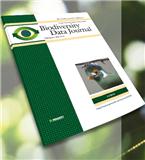- 投稿方式--官网投稿
-
期刊属性
-
- 中科分区:4区
- OA期刊:是
-
- 综述期刊:否
- TOP期刊:否
-
- 期均国文:67
- 环比增速:22.22%
-
期刊信息
- 研究方向:环境科学与生态学-BIODIVERSITY CONSERVATION生物多样性保护
- 国际刊号:ISSN: 1314-2836;E-ISSN: 1314-2828
-
- 期刊语言:英语
- 出版地区:保加利亚
- 投稿网址:https://arpha.pensoft.net/
- 电子邮箱:
- 期刊官网:https://bdj.pensoft.net/
- 作者指南:
- 出版商网址:http://www.pensoft.net
- 出版地址:PENSOFT PUBL, 12 PROF GEORGI ZLATARSKI ST, SOFIA, BULGARIA, 1700
- 期刊简介:BIODIVERSITY DATA JOURNAL《生物多样性数据杂志》(一年1卷). Biodiversity Data Journal (BDJ) is a community peer-reviewed, open access, comprehensive online platform, designed to accelerate publishing, dissemination and sharing of biodiversity-related data of any kind. The journal will publish papers in biodiversity science containing taxonomic, floristic/faunistic, morphological, genomic, phylogenetic, ecological or environmental data on any taxon of any geological era from any part of the world with no lower or upper limit to manuscript size.
-
万维提示
-
1、投稿方式:在线投稿。
2、期刊网址:https://bdj.pensoft.net/
3、投稿网址:http://arpha.pensoft.net/
4、官网邮箱:bdj@pensoft.net(编辑部)
(更多编辑邮箱请查看期刊官网信息)
5、官网电话:+359-2-8704281
6、期刊刊期:期刊以Continuous publication形式出版,一年出版1卷。
2021年11月8日星期一
投稿须知【官网信息】
Guidelines for Authors
BDJ uses the highly automated and user-friendly ARPHA Writing Tool (AWT), which navigates you during the authoring and submission process. A Tips & Tricks practical guide to the technicalities within the tool is also available.
The submission process in BDJ starts with creating a manuscript in AWT via the Start new manuscript button. AWT offers a number of fixed yet flexible article templates for each article type available in BDJ. Please note that the article templates cannot be changed once the writing process has started.
What article types can I choose from?
Data Paper
Description of large datasets. Should contain a link to openly accessible described data. Alternatively, datasets can be uploaded and published as supplementary files.
Forum Paper
Publication meant to initiate a discussion on a particular scientific topic.
Methods
Description of the experiments and their rationale used for a research outcome to be concluded and verified.
R Package
Description of an R Package including information on its purpose, installation and usage.
Software Description
Description of a software or online platforms. Contains a link to an openly accessible code.
Commentary
Short free-text publication meant to draw attention or criticise a previously published work. Does not include original data.
Alien Species Profile
Assessment report of alien or invasive species following an IUCN-compliant species template. After publication, the article can be exported to the Global Invasive Species Database (GISD).
Interactive Key
Online interactive identification key of a given higher taxon or species group. Contains a link to an openly accessible described online key.
Research Article
Publication of a study concluding significant new and original information.
Single Taxon Treatment
Publication of a single new taxon, new synonym, change in taxonomic status, re-description, biological / ecological observations on a single species, and others.
Species Conservation Profiles
A single or multiple IUCN species assessment report(s) imported and edited in an IUCN-compliant species template.
Editorial
Opinion article written by the senior editorial staff.
Short Communications
Short article (usually 3-4 pages) addressing interesting findings, unique approaches, controversial opinions, new methods or innovative technologies etc. and demands fast publication.
Manuscripts will be accepted for publication only if the following criteria are fulfilled:
Papers and associated data must contribute to a better understanding of the topic under scrutiny. Studies that have already been published or submissions that are currently under consideration for publication elsewhere will not be accepted for publication.
Previously published information should be considered and cited in compliance with the good academic practice. References should be complete and accurate. All figures included in manuscripts should be copyright free and duly acknowledge the original source.
All data underpinning an article, including data tables on which graphs are produced, must be published alongside the paper, e.g. as supplementary files, or links to external repositories where data are deposited, and contain sufficient metadata to facilitate data discovery.
Manuscripts must be submitted in English - either British/Commonwealth or American English. Authors should confirm the English language quality of their texts or alternatively request thorough linguistic editing prior to peer-review at a price. Manuscripts written in poor English are a subject of rejection prior to peer-review.
Manuscripts should be concisely written, in a good academic style, and follow a logical sequence. The voice - active or passive - and the tense used should be consistent throughout the manuscript. Results should be clearly and concisely described and supported by the data published with the article, or data published elsewhere but linked to the article.
Materials and Methods
In line with responsible and reproducible research, as well as FAIR data principles, we highly recommend that authors describe in detail and deposit their science methods and laboratory protocols in the open access repository protocols.io.
Once deposited on protocols.io, protocols and methods will be issued a unique digital object identifier (DOI), which could be then used to link a manuscript to the relevant deposited protocol. By doing this, authors could allow for editors and peers to access the protocol when reviewing the submission to significantly expedite the process.
Furthermore, an author could open up his/her protocol to the public at the click of a button as soon as their article is published.
Stepwise instructions:
1. Prepare a detailed protocol via protocols.io.
2. Click Get DOI to assign a persistent identifier to your protocol.
3. Add the DOI link to the Methods section of your manuscript prior to submitting it for peer review.
4. Click Publish to make your protocol openly accessible as soon as your article is published (optional).
5. Update your protocols anytime.
……
更多详情:
https://bdj.pensoft.net/about#For-authors
- Contemporary Physics《当代物理学》
- Discrete Analysis《离散分析》
- Chemical Industry & Chemical Engineering Quarterly《化学工业与化学工程
- ARP Rheumatology《ARP风湿病学》(原:Acta Reumatologica Portuguesa)
- ZFW-Advances in Economic Geography《ZFW:经济地理学进展》(原:Zeitschrif
- Yale Journal of Biology and Medicine《耶鲁生物学与医学杂志》
- Turkish Journal of Zoology《土耳其动物学杂志》
- Turkish Journal of Veterinary & Animal Sciences《土耳其兽医与动物科学杂志
- The Turkish Journal of Pediatrics《土耳其儿科杂志》
- Turkish Journal of Medical Sciences《土耳其医学杂志》
- Reproductive Sciences《生殖科学》
- Rejuvenation Research《抗衰老研究》
- Die Radiologie《放射学》(原:Der Radiologe)
- Quarterly Reviews of Biophysics《生物物理学评论季刊》
- Psychiatry and Clinical Neurosciences《精神病学与临床神经科学》
- Preventive Veterinary Medicine《预防兽医学》
- Physics of Particles and Nuclei《粒子核物理学》
- Numerical Linear Algebra with Applications《数值线性代数及其应用》
- Nanoscale and Microscale Thermophysical Engineering《微/纳尺度热物理
- Matrix Biology《基质生物学》

